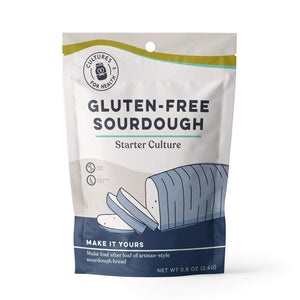
These fun, Asian-style noodles are made quite differently than traditional pasta. While the technique is more like making a crepe, the result is a chewy, satisfying noodle that makes a great addition to soups or stir-fries! These noodles are best eaten immediately after cooking so feel free to halve the recipe for a smaller batch.
20 minutes
180 minutes
4
INGREDIENTS AND EQUIPMENT AVAILABLE AT CULTURES FOR HEALTH
Gluten-Free Sourdough Starter

Gluten-Free Sourdough Starter Culture
$14.99
Not eating gluten? No problem! With the help of our gluten free sourdough starter culture, you can make tangy, fluffy sourdough bread that’s gluten-free.
The GF sourdough starter is an heirloom culture, meaning you'll make endless bread dough all from one starter! Just add water and gluten-free flour.
Sourdough is perfect for beginners, and this gluten free sourdough bread starter is a very forgiving culture and one of the easiest to work with!
INGREDIENTS:
- 2 1/2 cups rice flour
- 2 cups tapioca flour
- 1/2 cup gluten-free sourdough starter
- 4 3/4 cups water
- Peanut or grapeseed oil for cooking
INSTRUCTIONS:
- Whisk the flours, gluten-free sourdough starter, and water together in a large bowl. Continue to whisk until a very smooth texture is achieved. Cover tightly and allow to ferment for 6-12 hours.
- When ready to cook the noodles, whisk the batter again to make sure it is smooth and homogeneous.
- Preheat a 10 inch cast-iron or nonstick skillet over medium heat. Once hot, add a few drops of oil to the pan, adding more as needed to lightly coat the pan.
- Pour approximately 1/3 cup of batter into skillet. Swirl quickly to evenly coat the bottom of the skillet in batter.
- Allow to cook for a couple of minutes, or until the edges have pulled away from the pan, the top is firm, and tiny holes have developed on the surface of the noodle crepe.
- Immediately invert onto a lightly greased plate. Drizzle noodle crepe with additional oil to prevent sticking between noodle crepes.
- Repeat cooking steps with remaining batter, being sure to grease the pan and the noodle crepe between each batch.
- Once all batches have been cooked, cut stacked noodle crepes into noodles of a desired width. Wider noodles are generally more traditional for this type of noodle and also hold up better than thin-cut noodles.
To serve: Add to hot, flavorful broth for soup or add to a hot stir-fry just at the end of cooking. Noodles added to soups or other dishes should not be cooked for extra time as they are already cooked through and may begin to fall apart.















